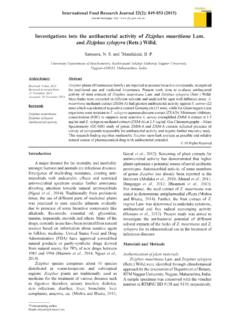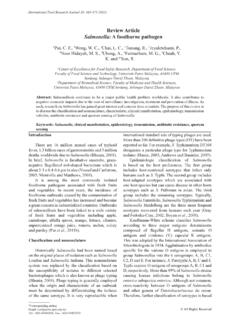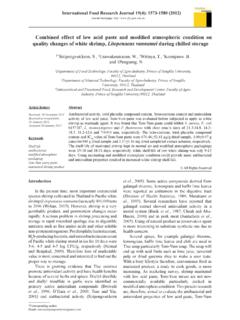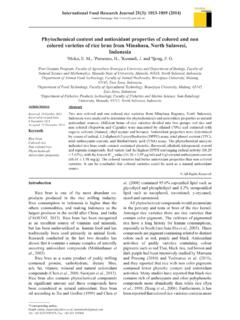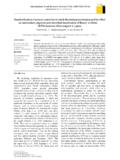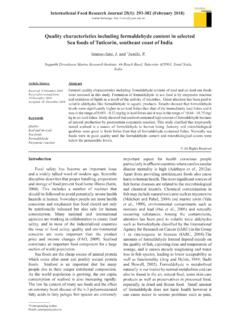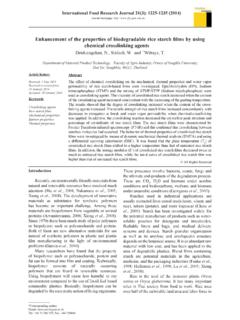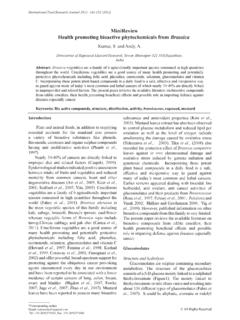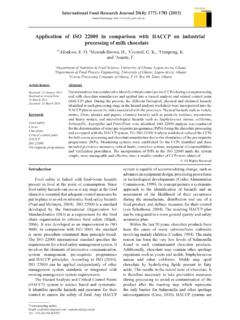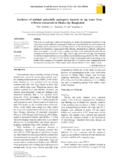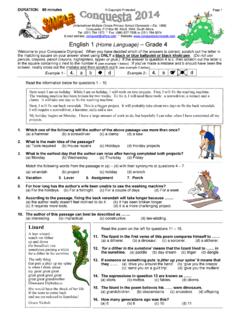Transcription of Textural, cooking quality, and sensory evaluation …
1 All Rights Reserved*Corresponding author. Email: International Food Research Journal 21(4): 1623-1627 (2014)Journal homepage: *Purwandari, U., 1 Khoiri, A., 1 Muchlis, M., 1 Noriandita, B., 1 Zeni, , 1 Lisdayana, N. and 2 Fauziyah, of Agroindustrial Technology, Faculty of Agriculture, Universitas Trunjoyo Madura, East Java Province, Indonesia2 Department of Agribusiness, Faculty of Agriculture, Universitas Trunojoyo Madura, East Java Province, IndonesiaTextural, cooking quality , and sensory evaluation of gluten-free noodle made from breadfruit , konjac, or pumpkin flourAbstractThree types of gluten-free noodle were made using flour of breadfruit , konjac, and blend of pumpkin and tapioca. Due to different characteristics of the three raw material, preparation were carried out in three different methods in three separate experiments. breadfruit and pumpkin noodle were made by using a texturing agent: fermented cassava flour and tapioca flour, respectively.
2 Whilst, konjac noodle did not need any texturing agent. This work aims to study the effect of preparation method of each type of noodle on textural and sensory properties of gluten-free noodles. Results showed that samples of breadfruit noodle had hardness ranging from 2520 to 3890 g and had preference score of out of 9. Water ratio in pregelatinized flour, and proportion of dry breadfruit flour in noodle dough affected hardness of breadfruit noodle, while interaction of the two factors influenced hardness, adhesiveness and cooking time of breadfruit noodle. cooking loss was not affected by preparation method. cooking time of breadfruit noodle ranging from to min, and cooking loss ranging from to Konjac noodle textural characteristics were affected by preparation method being examined. Konjac noodle had hardness of 3094 to 5204 g and adhesiveness of -406 to -920 g.
3 cooking quality of konjac noodle was not reported. sensory evaluation of konjac noodle was influenced by preparation method, and the highest score for overall preference was out of 9. Pumpkin noodle had hardness ranging from 2237 to 4954 g, and adhesiveness of to g, cooking time ranging from to min, and cooking loss was to The highest preference score was given to noodle containing 54% pumpkin has been increasingly important food commodity worldwide, with annual production of 101,420 million packs in 2012, and a steady increase of 3% annually since 2010 (World Instant Noodle Association, 2013). Most noodle is made of wheat as raw material, thus noodle consumption led to a dependency on massive imported wheat in non-wheat producing countries. Apart from wheat importation, wheat consumption may cause allergy, asthma, autoimmune response, or gluten sensitivity (Rosell et al.)
4 , 2013) in some group of people, leading to increasing demand of gluten-free products. Therefore, it is imperative to create new types of noodle made from non-wheat flour. Several works have been done on gluten-free noodle using different types of flour, although rice flour (Inglett et al., 2005; Yadav et al., 2011; Heo et al., 2013b) seems to be the best replacement for its small granule sizes to benefit noodle textural characteristics. Some other raw materials for gluten-free noodle include sorghum (Liu et al., 2012), and corn starch (Yuan et al., 2008; Yousif et al., 2012) or corn flour (Padalino et al., 2013). Lately, sweet potato starch (Silva et al., 2013), pseudo-cereal such as amaranth flour in combination with cassava starch (Fiorda et al., 2013) were also used for the making of gluten-free pasta. The absence of gluten in non-wheat noodle compositions adversely affects noodle quality .
5 Therefore, non-gluten-free noodle was treated to improve its characteristics. Several techniques commonly used for starch textural improvement are annealing and hydrothermal treatment (Hormdok and Noomhorm, 2007), gelatinization (Yousif et al., 2012), fermentation (Yuan et al., 2008), addition of hydrocolloids such as carboxymethylcellulose (Choy et al., 2012), addition of konjac glucomannan (Zhou et al., 2013), -glucan (Inglett et al., 2005; Heo et al., 2013a), addition of transglutaminase (Gan et al., 2009; Kim et al., 2014), and acetylated starch (Choy et al., 2012). In this work, pumpkin, konjac, KeywordsBreadfruitKonjacPumpkinTextureSe nsoryArticle historyReceived: 24 November 2013 Received in revised form: 5 February 2014 Accepted: 6 February 20141624 Purwandari et 21(4): 1623-1627or breadfruit , was used to make gluten-free noodles, and to study textural and sensory properties of noodle as affected by preparation method.
6 Each noodle was made using different preparation makingFirst step was preparing flour from the three raw materials for gluten-free noodle. Similar method was applied to breadfruit , konjac corm, and pumpkin. Mature but unripe breadfruit commercially available in local market in Kamal, Madura, Indonesia, was peeled, and then sliced about 1-2 mm thick. The slices were soaked into a 1% sodium metabisulphite solution for 5 minutes, then drained well. Three times washing with water were done to remove excess of sodium metabisulphite. It was then followed by drying in a cabinet dryer at 55 C until the chips were fully dry. They were then ground using electric grinder, and passed through a 60 mesh sieve. breadfruit flour was kept in a tight container until its uses. Fully mature konjac corms were bought from local market in Nganjuk, East Java Province, Indonesia.
7 Pumpkin was collected from local market in Sampang, Madura, Indonesia. The corms and pumpkin were treated similary as breadfruit to make type of noodle was made using three different methods, due to individual characteristics of raw material. The breadfruit noodle was made by mixing it with pregelatinised fungal fermented cassava flour (Purwandari, 2000) as texturing agent. The preparation of pregelatinised flour varied in flour to water proportions of 1:4, 1:5, 1:6 (w/w). The suspension was heated using moderate heat on a hot plate (85 C) until all starch gelled. This gel was then mixed in ratios of pregelatinised to breadfruit flour of 1:10, 1:11, 1:12 (w/w). After mixing, the dough was let to stand for 30 min at room temperature. It was then passed into a roller 7-9 times until smooth sheet was formed, then cut into strips of 10 mm width and 1 mm thick.
8 The strips were steamed for about 30 min or until opaque in the center of strip disappeared, then they were dried in a cabinet dryer at 55 C until dry. Konjac noodle was firstly made by preparing pregelatinised konjac flour and water of various ratios: 1:10, 1:11, 1:12 (w/w). The pregelatinised flour was then mixed with dry konjac flour in ratios of 1 , 1 , 1 (w/w). After equilibration, the dough was made into smooth sheet, and then cut into strips, steamed, dried, and stored. Pumpkin noodle was made by mixing pumpkin flour with tapioca flour with various ratios of 41:59, 39:61, 36:64, 37:63, 34:66, 32:68 (w/w). Distilled water was then added at 83, 75, and 67% (w/w). After mixing, the dough was passed into a roller 7-9 times until smooth and elastic sheet was formed; cut, steamed, and dried in a cabinet dryer at 50 C until the strips were fully propertiesTextural characteristics of noodle were measured as hardness and adhesiveness on a texture analyser TA-XT Plus (Stable Micro Systems, Surrey, UK).
9 Ten 10 cm-long dried noodle strips taken from two separate batches of every treatment was put into a boiling distilled water according to their cooking time to enable gelling of all part of noodles, then were drained and cooled at room temperature for around 10 min, then put each strip under the probe. The probe used was a cylider type with 35 mm diameter (P/35). cooking qualityDried breadfruit and pumpkin noodle was subjected to cooking loss, cooking time, and water absorption measurement, according to a standard method by AACC (2000) with some modifications. Dried noodle strips (10 cm long) of known weight were cooked in boiling water about 10 times weight of dried noodles. First, cooking time was determined by put strips into boiling water, and checked the disappearance of opaque at the center of the strip. The time of disappearance of opaque center was recorded as cooking time.
10 cooking loss was determined as the quantity of dry solid in cooking distilled water after cooking noodle strips according to their cooking time, expressed as percentage over the weight of dried noodles. Water absorption was the increase in weight of dried noodles after cooking in boiling water according to their cooking evaluationSensory test was carried out by employing 20 untrained panelists from University students and staff. They were asked to score their preferences for sensory attributes (colour, aroma, taste, mouth feel, and overall) of cooked noodles, ranging from 1 (dislike very much) to 9 (like very much), using questionnaire sheets. Data processingAnalysis of variance of data of each type of noodle was carried out on a statistical package SPSS (SPSS Inc.), for full factorial design consisting two factors with three levels for each factor.
